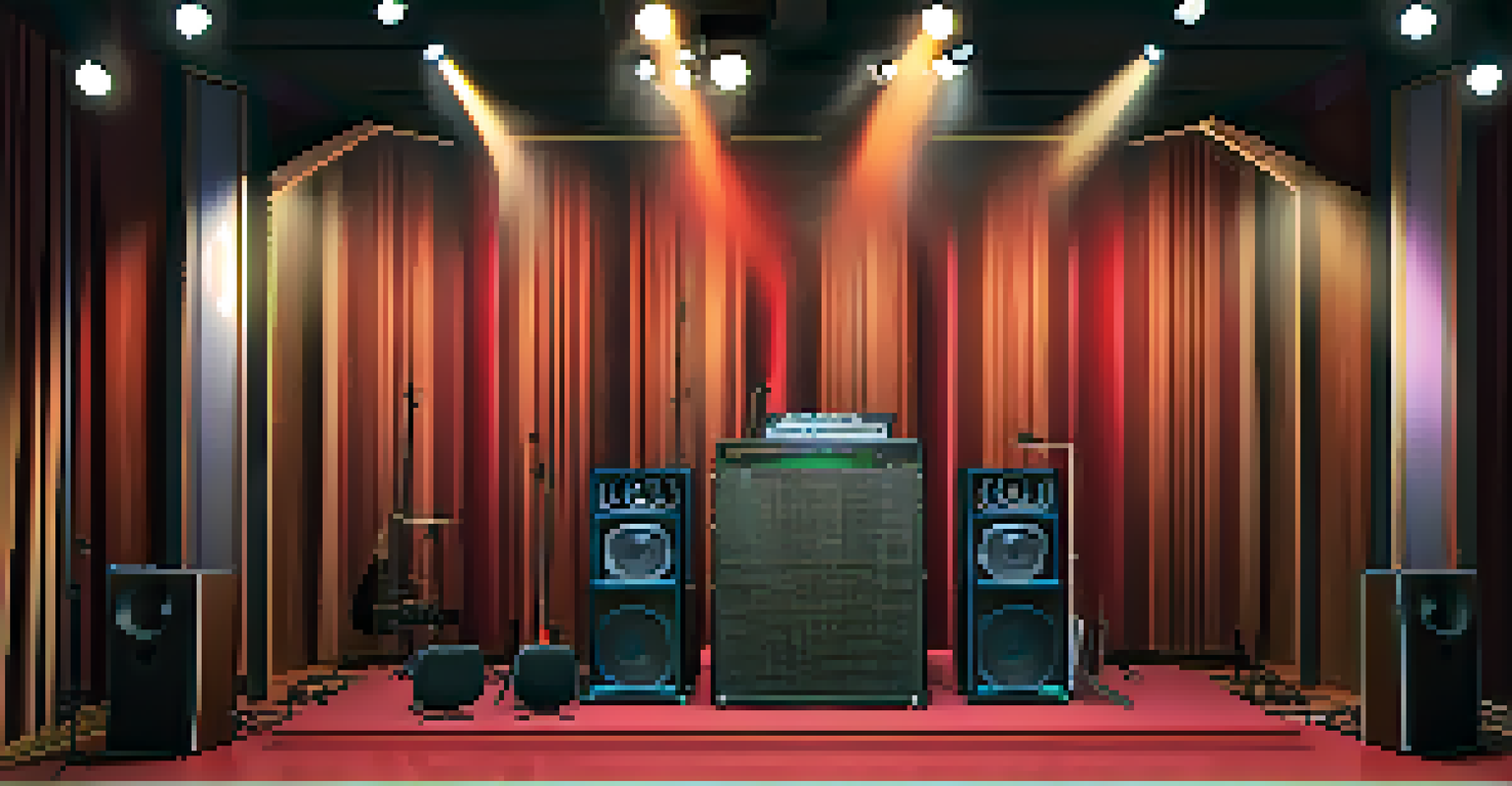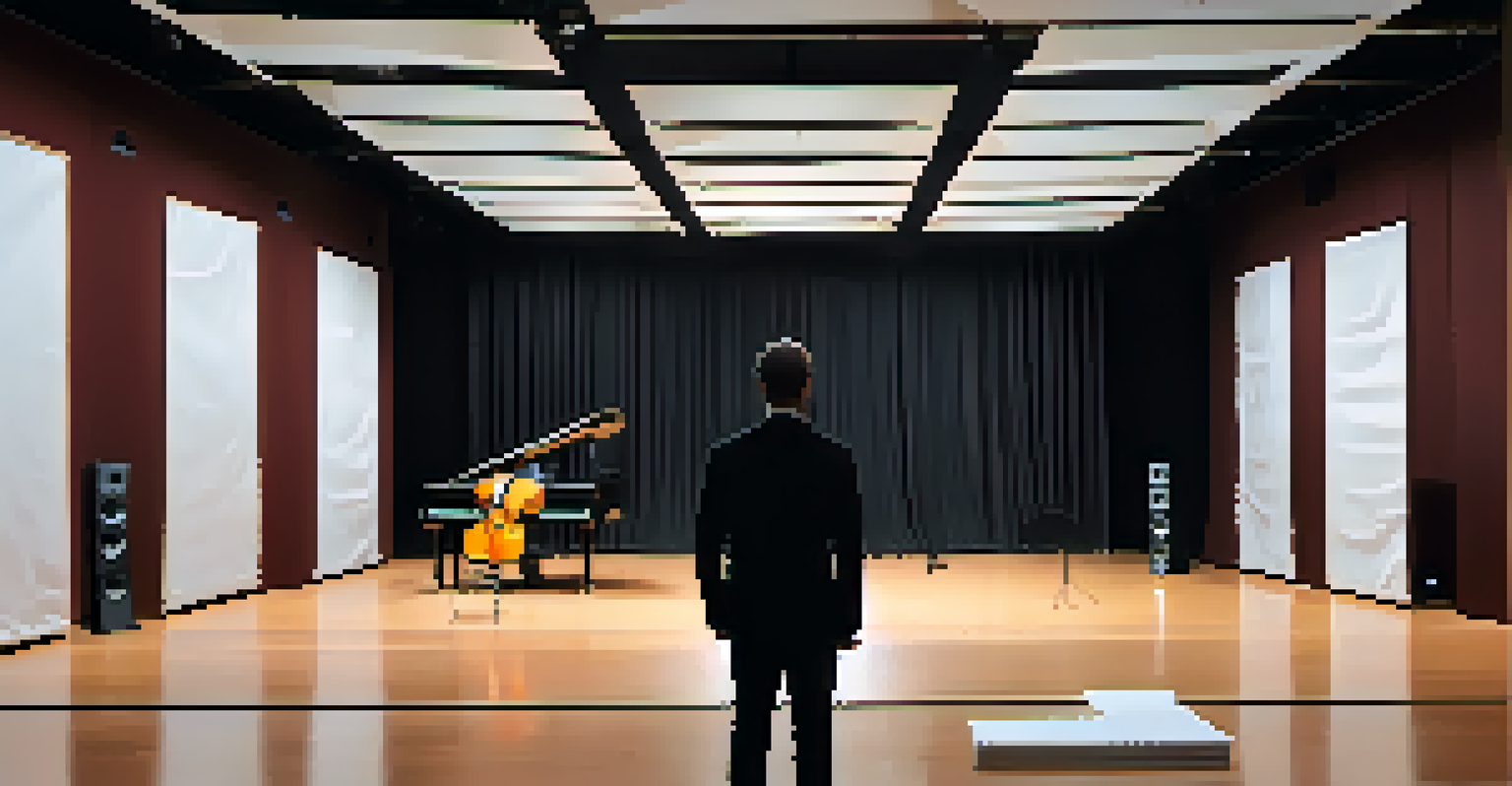Acoustic Treatment Techniques for Live Performance Spaces

Understanding Acoustic Treatment in Performance Spaces
Acoustic treatment is essential for enhancing sound quality in live performance spaces. It involves modifying the environment to control sound reflections, absorption, and diffusion. This ensures that the audience enjoys clear and immersive audio, whether it's a concert, theater performance, or a spoken word event.
Sound is the vocabulary of nature.
By focusing on how sound behaves within a space, acoustic treatment can significantly improve the listening experience. For instance, untreated spaces may cause echoes or muddled sound, making it hard for the audience to appreciate the performance. Effective treatment creates a balanced audio environment where music and speech can shine.
Understanding the basics of sound waves and how they interact with different materials is crucial. This knowledge helps in selecting appropriate treatment techniques tailored to specific venues, ensuring that every performance resonates perfectly with the audience.
Identifying Key Acoustic Challenges in Venues
Every performance space has its unique acoustic challenges, influenced by size, shape, and materials. Common issues include excessive reverb, poor sound isolation, and uneven sound distribution. Identifying these challenges is the first step in implementing effective acoustic treatment.

For example, a large concert hall may struggle with echoes, while a small club could face sound bleed from neighboring rooms. Understanding these specific challenges allows venue managers to create targeted solutions that enhance sound quality. Without addressing these issues, the overall experience can be compromised.
Importance of Acoustic Treatment
Acoustic treatment is vital for enhancing sound quality and ensuring clear audio in live performance spaces.
Conducting an acoustic analysis can provide insights into how sound behaves within the space. This analysis can reveal areas that require treatment and inform the selection of materials and techniques to overcome the identified challenges.
Utilizing Absorption Materials for Sound Control
Absorption materials play a vital role in reducing unwanted sound reflections. They are designed to absorb sound waves, preventing them from bouncing around the room. Common materials include acoustic panels, foam, and curtains, which can be strategically placed to improve sound clarity.
The right sound can create a world, while the wrong sound can destroy it.
For instance, installing foam panels on walls can significantly dampen high-frequency reflections that cause harshness. Similarly, heavy curtains can absorb sound in spaces with large windows, reducing outside noise interference. Choosing the right type of absorption material is critical for achieving the desired acoustic effect.
When implementing absorption techniques, it’s important to strike a balance. While too much absorption can lead to a dull sound, too little can create echoes. A well-thought-out approach ensures that the space maintains a lively yet controlled acoustic environment.
Incorporating Diffusion Techniques for Balanced Sound
Diffusion techniques help scatter sound waves evenly throughout a space, preventing the buildup of echo and enhancing overall sound quality. Diffusers can be made from various materials, including wood or plastic, and are often designed in complex shapes to break up sound waves effectively.
For example, placing diffusers on the back wall of a performance space can help maintain richness in sound while reducing harsh reflections. This technique is particularly useful in larger venues where sound may otherwise become too focused in certain areas. It allows for a more immersive experience for the audience.
Addressing Acoustic Challenges
Identifying specific acoustic challenges in venues allows for tailored solutions that significantly improve sound quality.
Incorporating diffusion alongside absorption creates a harmonious acoustic environment. By managing both the absorption of excess sound and the diffusion of remaining waves, venues can achieve the perfect balance for any performance style.
The Role of Bass Traps in Low-Frequency Control
Bass traps are specialized acoustic treatment devices designed to manage low-frequency sound waves. These waves can often resonate in corners and create muddiness in the audio, particularly in live performance settings. Installing bass traps can help in controlling these frequencies for a clearer sound experience.
For instance, placing bass traps in the corners of a room can significantly reduce the buildup of low frequencies that can overshadow vocals and instruments. This treatment is essential for genres that rely heavily on bass, such as jazz or electronic music. It allows for a more balanced sound across the frequency spectrum.
Incorporating bass traps into an acoustic treatment plan not only improves sound quality but also enhances the overall enjoyment of a performance. By addressing low-frequency challenges, venues can create a more pleasant listening atmosphere for their audiences.
Design Considerations for Acoustic Treatment Implementation
Designing an effective acoustic treatment plan requires careful consideration of both aesthetics and functionality. The visual appeal of treatment materials can impact the overall ambiance of a performance space. Selecting attractive acoustic panels or diffusers can enhance the venue’s design while serving their acoustic purpose.
For example, wooden panels can provide a warm, visually appealing look while also absorbing sound. This integration of design and function helps create a space that is not only acoustically sound but also inviting for performers and audiences alike. The goal is to maintain the venue’s character without compromising audio quality.
Future Trends in Acoustic Design
The future of acoustic treatment includes advancements in technology and a shift towards eco-friendly materials.
Involving an acoustic consultant during the design phase can help ensure that treatment solutions are both effective and visually integrated. Their expertise can guide the selection of materials and placement, leading to a balanced space that enhances the live performance experience.
Maintaining Acoustic Treatment for Long-Lasting Results
Once acoustic treatment is installed, ongoing maintenance is crucial for ensuring its effectiveness. Dust and wear can diminish the performance of sound-absorbing materials, so regular cleaning and inspection are necessary. Keeping these surfaces in good condition helps maintain optimal acoustic quality.
For example, fabric panels may need to be vacuumed or washed periodically, while foam panels should be checked for degradation over time. Ensuring that all treatment elements are functioning properly can prevent issues that arise from neglect. Regular maintenance extends the lifespan of the acoustic treatment investment.

Additionally, re-evaluating the acoustic environment periodically can help identify any new challenges that may arise. As venues host a variety of performances, ongoing assessment ensures that the space remains acoustically optimized for diverse events and evolving needs.
The Future of Acoustic Treatment in Live Venues
The future of acoustic treatment in live performance spaces is evolving with advancements in technology and design. Innovations such as smart acoustic panels that adapt to sound levels are being developed, offering exciting possibilities for enhancing live sound experiences. These technologies can provide real-time adjustments to optimize acoustics based on performance needs.
Moreover, as sustainability becomes increasingly important, there is a growing trend towards eco-friendly materials in acoustic treatment. Utilizing recycled or sustainably-sourced materials not only enhances sound quality but also aligns with environmental values, appealing to a broader audience. This shift reflects a commitment to both performance excellence and responsible practices.
As the industry continues to adapt, embracing both traditional and innovative acoustic treatment techniques will be key. By staying informed about emerging trends and technologies, venues can ensure they remain at the forefront of delivering exceptional audio experiences for all types of performances.